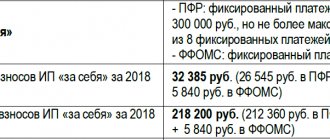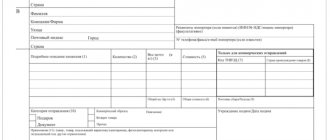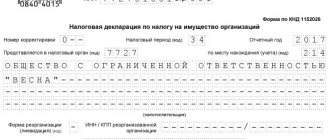What is a simplified system and who is it for?
The simplified taxation system is a special taxation regime for small businesses, the main features of which are simpler accounting and reporting, as well as the ability to pay one tax instead of several mandatory ones.
What taxes is an entrepreneur exempt from under the simplified tax system? These are personal income tax (PIT) for yourself, value added tax (VAT) and property tax. However, there are exceptions for each of these taxes, for example, an entrepreneur is required to pay personal income tax for hired employees; VAT – when importing goods from abroad; certain types of real estate on which tax is calculated are specified in Article 378.2 of the Tax Code of the Russian Federation.
The obligation of an entrepreneur on the simplified tax system, in addition to paying a single tax, is to transfer insurance contributions to the budget for himself and his employees (if any). The individual entrepreneur must pay pension contributions and health insurance for himself.
The primary legislative source for the simplified tax system is Chapter 26.2 of the Tax Code of the Russian Federation, which you can always refer to if additional questions arise.
Let us immediately note that not all entrepreneurs can use the simplified tax system. It is prohibited to be “simplistic” if your activity is related to:
- production of goods subject to payment of indirect tax - excise tax (alcoholic beverages, tobacco products, fuel, etc.); — mining of minerals, except non-metallic ones, used as building materials (sand, clay, limestone, etc.); — legal practice or notary practice; - gambling; — insurance, investment, banking services, securities, pawnshops. In addition, you cannot use the simplified tax system if you have more than 100 employees, an annual income of more than 60 million rubles and a residual value of fixed assets of more than 100 million rubles.
How is property taxed in 2015?
Before 2015, entrepreneurs who chose the simplified taxation system did not pay property taxes. However, now this tax has been introduced and it mainly concerns real estate. Those objects that are included in the list of real estate objects and have a cadastral value are taxed. But still, not all entrepreneurs using the simplified system will pay this tax. It will primarily affect legal entities and organizations. These changes need to be clarified. And know exactly what the cadastral value of an object is and how it can be calculated. Taxes are imposed only on real estate that has a cadastral value.
For example, we can imagine an organization that owns both real estate and movable property. So, only real estate objects are subject to tax. This could be shopping centers and premises in these centers. Also, plots of land, houses and equipment . So, when included in regional lists, real estate receives a cadastral value and is also subject to taxation.
An entrepreneur who is on a simplified taxation system and who purchased an office in an office center in 2014 does not need to pay any taxes. And already in 2015, this entrepreneur must carefully monitor whether his property appears on the list of real estate with cadastral value. If this happens, then his property is subject to taxation.
What the amount of this tax will be is determined by regional law, since if an object is included in the regional lists, then it is also included in the regional real estate database. This is discussed in paragraph 7 of Art. 378.2 Tax Code of the Russian Federation; clause 1 art. 372 NKRF.
It turns out that only those taxpayers will pay if they live and operate in a region where there is such a law. If there is no such law in their region, then they should not make any payments. But sooner or later, the constituent entities of the Russian Federation will adopt a similar law. But when it is introduced, they must approve all lists of objects that have a cadastral value in advance. The list must be updated by January 1, 2015. If you find your property there, there is no need to avoid paying tax. In this case, the simplified tax system does not exempt you from payment. There is no need to pay anything only when the object is not included in the regional lists.
Let’s say that while looking through regional lists of property with cadastral value, you find your property there. In this case, carefully, very carefully study the regional law on this. How is tax paid and how much is it calculated? You also need to know the deadline for its payment and possible benefits.
Methods for determining the object of taxation under the simplified tax system.
There are two such methods, and the entrepreneur has the right to choose any of them at his own discretion:
1. The first method assumes that the object of the single tax will be the income of the entrepreneur. Such income recognizes both revenue received from sales during the conduct of the main activity, and income received in other ways (donated property, interest income on deposits, securities, etc.). 2. The second method assumes that the object of the single tax will be the difference between income and expenses. You can find out the full list of income and expenses by referring to the primary sources - Articles 346.15 and 346.16 of the Tax Code of the Russian Federation, respectively.
Compensation can now be written off
Under the simplified taxation system, labor costs can include all the same payments as when calculating income tax (subclause 6, clause 1, clause 2, article 346.16 of the Tax Code of the Russian Federation). Since January 1, 2015, the list of labor costs includes severance benefits that an employee receives upon termination of an employment contract by agreement of the parties (clause 9 of Article 255 of the Tax Code of the Russian Federation). This means that such payments can be taken into account without risk even on a simplified basis. The main thing is that the provision regarding them should be in the employment contract with the employee or in a separate agreement, including on termination of the employment contract, as well as a local act, for example, a regulation on remuneration.
The Russian Ministry of Finance has previously allowed the inclusion of compensation provided for in the additional agreement to the employment contract in labor costs (letter dated July 16, 2014 No. 03-03-06/1/34828). But tax officials believed that such payments can be taken into account only if they are of a production nature and related to the regime and working conditions of the employee (letter of the Federal Tax Service of Russia dated July 28, 2014 No. GD-4-3/14565).
Important numbers
RUB 68,820,000 — an income limit that allows you to work on a simplified basis until the end of 2015
RUB 51,615,000 — an income limit that allows you to switch to a simplified system from 2021
Individual entrepreneur simplified taxes 2015: rates.
The size of the single tax rate is influenced by the method of choosing the object of taxation:
6% - a single tax on the simplified tax system is levied on the income of entrepreneurs; 15% - a single tax is levied on the simplified tax system on the difference between income and expenses.
It should be noted here that the rate of 15% is not fixed, since the subjects of the federation set it independently. The law defines the possibility of reducing this rate to 5% in the case of attracting investments or developing priority activities in a given region. To do this, you need to contact the tax service with which you are registered.
Amounts of insurance premiums for individual entrepreneurs on the simplified tax system in 2015.
As we have already mentioned, an individual entrepreneur using the simplified tax system, in addition to the single tax, must pay insurance premiums for:
— pension provision; - health insurance.
Regarding insurance contributions to the Pension Fund for yourself, their value depends, on the one hand, on the size of the individual entrepreneur’s annual income, and on the other, on special parameters (the size of the minimum wage and insurance rates).
If an entrepreneur earns less than 300 thousand rubles a year, then he must transfer a fixed amount monthly to pension insurance: 1550.90 rubles = 5965 rubles (minimum wage in 2015) * 0.26 (insurance rate in the Pension Fund). Accordingly, the annual amount of insurance premiums will be: 1550.90 * 12 = 18610.80 rubles.
How will the amount of insurance payments for pensions change if income exceeds the threshold of 300 thousand rubles? Then you will need to pay an additional 1%, taken from the amount of this excess.
Regarding deductions for health insurance, there is no differentiation by income level; their size for all individual entrepreneurs has a fixed value: 304.23 rubles per month and, accordingly, 3650.58 rubles per year.
Limit on simplified tax system for 2015
In fact, we settled on a very important topic. The limit on the simplified tax system for 2015 must be known to all companies that use such a tax system. The chief accountant, the head of the company and other responsible persons will not be able to navigate their “ship” on the waves of success if they are not aware of the rapidly changing events in the legislation of the Russian Federation. The rhythms of our time are such that we, in fact, have only two possible life options: either adapt or perish. Agree that the second option is not entirely suitable for most leaders, because, as a rule, these people are wayward and life-loving.
Anyone who has tried to be a manager will never voluntarily join the rank and file to do menial work so that someone else gets the cream of the crop. Therefore, in order not to fall from the “throne”, the manager needs to follow all the innovations in the Russian Federation, including the limit on the simplified tax system for 2015. Although, it is probably wrong to say that only the head of the company monitors the limit under the simplified tax system for 2015. The chief accountant, along with other responsible persons, is usually also in the know. It is this team that leads the company to the pinnacle of financial well-being. If it is inactive and incurious, then, you see, such a company will not stay afloat for long. The work of every cog in the organization, every screw, so to speak, is important here. It is precisely for such coordinated team work that we are writing our article - the limit on the simplified tax system for 2015 - which is only part of one big work on paying taxes to an organization.
Everything we have described above is to convey to you our main idea - pay attention to the details of your huge or modest company. In this case, the limit on the simplified tax system for 2015 is just a trifle, at first glance, but systematically omitting such trifles can lead to collapse. If we give an example from life, then our question - the limit on the simplified tax system for 2015 - can be compared to a drop of rain. A leaky roof of a house will do absolutely nothing if a tiny drop of rain falls on it. But as soon as it really rains, when there are a lot of such drops, then expect trouble, because the leaky roof will not be able to withstand such pressure and a natural flood will occur for those people who are in the house. In this metaphor, our 2015 sleep limit theme is a raindrop. Therefore, solve these problems as they arise and do not procrastinate.
It seems that we have conveyed to you the importance of this topic, and now we can move on to the basic terms and to the answer to our main question - the limit on the simplified tax system for 2015.
What should an entrepreneur be guided by when choosing an object of taxation?
Many entrepreneurs starting their activities, as well as those who have been working for some time and want to reduce their tax burden, face this choice. Which object is more correct to choose – income or the difference between income and expenses?
The “income” method is extremely simple and convenient for entrepreneurs; the tax base for it is income received in the reporting period. There are no pitfalls or points that require explanation.
Regarding the “income minus expenses” method, in this case the individual entrepreneur must take into account a number of significant factors. Let's look at the points that individual entrepreneurs, first of all, need to pay attention to:
- Choosing the “income minus expenses” method requires clear documentation of all expense transactions. We are talking here about both documents confirming the transfer of goods or provision of services (acts, invoices), and certifying their payment (payment orders, checks, receipts). If the documents on expenses are drawn up incorrectly or are not available, then the right to use them when determining the object of taxation disappears - you simply will not be credited for such expenses. It also happens that not all counterparties provide documents signed by them on time. You will need to take care of this, since only you are interested in reducing the tax base. But even if you have all the documents confirming expenses, the tax service has the right not to recognize them if they do not comply with Article 346.16 of the Tax Code of the Russian Federation.
- The next important point of this method is the availability of prepayments. If the specifics of your activity are such that you use customers’ funds to purchase from suppliers, then in this case you need to very carefully monitor the deadlines. If in the reporting quarter it is not possible to transfer money to the supplier from the received advance payment, then you risk a large amount of the advance payment! After all, you did not have time to make expenses, which means that 15% (or less, depending on what rate is assigned to you) will be accrued on the amount of income received, that is, the prepayment. Of course, these expenses will be taken into account in the future, but not all individual entrepreneurs are able to pay a significant amount of tax at once.
- It would be more appropriate to choose this method only if expenses in total income amount to more than 60%.
- If in your region there are benefits for the chosen type of activity in the form of a rate reduction of up to 5%, this is a significant advantage in choosing the “income minus expenses” method. We note here that in this case the costs according to the previous paragraph may be less than 60%.
Thus, after weighing the indicated criteria, an entrepreneur can accurately make a choice in favor of one or another method of determining the tax base.
How to become a single tax payer using the simplified tax system?
An individual entrepreneur from the moment of his registration and over the next 30 days has the right to submit a special application to the tax service. This is the only thing that needs to be done when switching to a simplified taxation system. This right exists even before the start of business - directly when submitting registration documents.
If an individual entrepreneur is already working and wants to switch to the simplified tax system, then this right is granted only from the beginning of next year. In this case, he will need to submit an application this year. The deadline for submission is December 31 of the current year. The procedure is similar for those who want to change the object of taxation “income” to “income minus expenses” and vice versa. The transition will take place only from next year, provided that an application is submitted within the specified period this year.
If an entrepreneur paid a single tax on imputed income (for one or all types of activities), then, upon application, he can switch to the simplified tax system in the month in which he ceased to be a UTII payer.
Property tax for individuals 2015
On January 1, 2015, Chapter 32 of the Tax Code of the Russian Federation “Property tax for individuals” comes into force. The corresponding changes are introduced by Federal Law dated October 4, 2014 No. 284-FZ. At the same time, it repeals the previous Law of the Russian Federation “On taxes on property of individuals” dated December 9, 1991 No. 2003-1, which existed for more than 20 years.
The tax must be paid in relation to residential buildings and residential premises (apartments, rooms), garages (car spaces), single real estate complexes, unfinished construction projects, as well as other buildings, structures and structures.
Just as before, the tax authorities themselves will calculate the tax. Notice of payment and payment will be sent by mail - the procedure does not change here. The payment deadline has been slightly delayed. The tax will have to be paid a month earlier - no later than October 1, and not November 1, as in 2014.
Currently, tax is calculated based on inventory value. According to the new law, the base for calculating tax is equal to the cadastral value of the property. And this is the main difference between the new law and the old one. After all, the inventory value in practice is several times lower than the market value. This is especially true for old buildings, the inventory value of which includes physical wear and tear. But the inventory value of new houses and apartments is close to the market value (and therefore the cadastral value). From this it is easy to conclude that for owners of new real estate the tax amount will change insignificantly. But owners of old homes may feel the new law on their wallets.
True, the law provides for a transition period of several years, during which the tax burden will increase gradually.
The property tax law comes into force in 2015. But at present, not all regions have managed to conduct a cadastral valuation of real estate. Therefore, until your home has its own cadastral number, the tax will be considered based on the inventory value according to the old rules. But for those citizens whose property has already been assessed according to the rules of the cadastre, the law provides for relaxations.
When calculating the tax on the cadastral value of real estate, reducing coefficients will be applied for four years. The formula for calculation is quite complicated.
Real estate owned by businessmen is subject to a new property tax for individuals on a general basis. However, the Tax Code establishes benefits for those entrepreneurs who work on the simplified tax system, UTII or patent and use real estate in their business. The relevant rules on exemption are prescribed in paragraph 3 of Article 346.11 (for the simplified tax system), paragraph 4 of Article 346.26 of the Tax Code of the Russian Federation (for UTII), paragraph 10 of Article 346.43 of the Tax Code of the Russian Federation (for a patent). It clearly states that an entrepreneur does not pay personal property tax on real estate used in business.
Federal Law No. 284-FZ dated October 4, 2014, introducing a new Chapter 32 “Property Tax for Individuals” of the Tax Code of the Russian Federation, does not introduce any changes to Articles 346.11, 346.26 and 346.43 of the Tax Code of the Russian Federation. This means that benefits for entrepreneurs in the special regime continue to apply. That is, in 2015, if nothing changes, entrepreneurs will continue to be exempt from paying property tax. Thus, in order to exempt a businessman from paying property tax, the following conditions must be met:
- a businessman works on the simplified tax system, UTII or patent;
- The businessman's property is used in business.
Property tax for individuals is calculated by the Federal Tax Service. Therefore, a businessman must take care in advance to ensure that his real estate involved in business on the simplified tax system does not fall under taxation. To do this, you need to confirm your right to benefit. But how to do that? Federal Law No. 284-FZ dated October 4, 2014 does not establish any procedure for confirming the right to benefits for entrepreneurs on the simplified tax system. Paragraph 6 of Article 407 of the Tax Code of the Russian Federation, which comes into force on January 1, 2015, speaks only of the general procedure for confirming benefits by citizens, and not by entrepreneurs. Namely: the citizen submits to the inspectorate an application for benefits and documents confirming the right to benefits.
However, the current law on property tax (dated 09.12.91 No. 2003-1) did not stipulate a special procedure for confirming the right to a benefit. And entrepreneurs in practice used the explanations given, for example, in the letter of the Federal Tax Service of Russia dated August 19, 2009 No. 3-5-04/1290.
In our opinion, these same recommendations can continue to be used in 2015. So, in order to exempt your property from taxation, submit an application to the Federal Tax Service in any form. In it, list the real estate objects that are exempt from property tax due to the fact that you use them in activities subject to a “simplified” tax. Attach to the application copies of documents confirming the actual use of the property in business activities (agreements with suppliers, buyers, tenants, payment documents, etc.).
You need to submit your application as early as possible. The deadline to pay property taxes for 2015 is October 1, 2021. It is clear that tax authorities will calculate the tax and send payment notices before this deadline. Therefore, prepare your documents in advance.
Concepts of tax and reporting period according to the simplified tax system. An example of calculating an advance payment.
The tax period for individual entrepreneurs using the simplified tax system is a calendar year, and the reporting period is a quarter. The declaration is submitted once a year until April 30 of the following reporting year. And although the reporting period for individual entrepreneurs is three months (quarter), there is no need to file a declaration for this period, however, entrepreneurs are required to independently calculate and pay advance payments for the single tax on the simplified tax system on a quarterly basis. In this case, the advance amount is determined as follows: the tax base in each subsequent quarter is taken on an accrual basis, multiplied by the appropriate tax rate, and the previously paid tax is subtracted from the resulting amount. For the 1st-3rd quarters of the current year, advances are paid until the 25th of April, July and October, respectively. But the final tax amount at the end of the tax period is due until March 30 of the next year.
An important point when calculating advances: • Individual entrepreneurs on a single tax of 6% (the “income” method) reduce the amount of the tax base by the amount of insurance premiums; • Individual entrepreneurs with a single tax of 15% or less (the “income minus expenses” method) include insurance premiums as expenses.
Let's consider an example: an entrepreneur is a single tax payer under the simplified tax system at a rate of 6%. In the first quarter his income was 50 thousand rubles, in the second - 80 thousand rubles, in the third - 100 thousand rubles and in the fourth - 60 thousand rubles. The entrepreneur's annual income was: 50 + 80 + 100 + 60 = 290 thousand rubles. The total amount of monthly insurance premiums for yourself is: 304.23 (FFOMS) + 1550.90 (PFR) = 1855.13 rubles. Since payment of advances under the simplified tax system is carried out quarterly, it is advisable to determine the amount of insurance premiums for this period: 1855.13 rubles * 3 = 5565.39 rubles. By April 25, the individual entrepreneur must pay to the budget: (50,000 rubles - 5565.39) * 6% = 2666.08 rubles. By July 25, the individual entrepreneur must pay to the budget: (50,000 rubles + 80,000 rubles - 5565.39 * 2) * 6% - 2666.08 rubles = 4466.07 rubles. Until October 25, the individual entrepreneur must pay to the budget: (50,000 rubles + 80,000 rubles + 100,000 rubles - 5565.39 * 3) * 6% - (2666.08 rubles + 4466.07 rubles) = 5666.08 rubles. The final tax amount for the year must be paid before March 30 of the next year and will be: (290,000 rubles - 5565.39 * 4) * 6% - (2666.08 rubles + 4466.07 rubles + 5666.08 rubles) = 3266, 08 rubles. Thus, the total amount of the single tax on the simplified tax system for the year, which will be included in the declaration, will be: 2666.08 rubles + 4466.07 rubles + 5666.08 rubles + 3266.08 rubles = 16064.31 rubles. Please note that the established payment deadlines are required to be met in order to avoid fines and penalties. For each day of non-payment of tax, a penalty is charged, amounting to 1/3 of the Central Bank refinancing rate. In addition, in case of late payment of tax based on the results of the year, a 20% fine of the amount of underpayment will be charged.
Current limits for simplified tax system
When it comes to limits, businessmen first of all remember income, but the simplified tax system also provides for other restrictions. Individual entrepreneurs and legal entities using the simplified tax system should remember the following maximum limits established for 2021 (Articles 346.12, 346.13 of the Tax Code of the Russian Federation):
- 150 million rub. — income for the year;
- 100 people - average number of employees;
- 150 million rub. — residual value of fixed assets at the end of the reporting period.
There are two additional points for organizations:
- activities without opening branches;
- the share of other legal entities in the authorized capital should not exceed 25%.
These restrictions apply both to those already working on the simplified tax system and to those wishing to switch to it from the new year. For future “simplers”, the revenue limit is determined for 9 months of the year preceding the transition and amounts to 112.5 million rubles.
An exception has been made for individual entrepreneurs - in order to switch to the simplified tax system, entrepreneurs may not comply with the limits on revenue and fixed assets, since they are not required to keep accounting and may simply not know these parameters (letter of the Ministry of Finance of the Russian Federation dated November 5, 2013 N 03-11-11/47084 ). But after the transition to the simplified tax system, entrepreneurs will also have to comply with the restrictions, otherwise they will lose the right to apply this special regime.
Until 2021, increasing coefficients were established annually to calculate the revenue limit. Limit increases were frozen from 2021 to 2021. For 2021, a coefficient of 1 has been established. Therefore, businessmen can expect an increase in the 150 million income limit only from 2021.
What are the advantages of “simplified”?
The attractiveness of the simplified system for individual entrepreneurs is obvious, since it has a number of advantages: 1. Simplified reporting - the declaration is submitted once a year. 2. Simple accounting, no need for accounting. 3. Reduced tax rates compared to the general taxation system. 4. The ability to reduce the tax base through insurance premiums (using the “income” method). 5. Due to simplified accounting, there is little interest from the tax service in “simplified” people, an almost complete absence of on-site inspections and pressure.
Summing up the topic “individual entrepreneur taxes simplified 2015”, one significant drawback can be identified, despite all the listed advantages - this is the inability of counterparties - VAT employees working with individual entrepreneurs - to receive a VAT tax deduction. Under such circumstances, enterprises that pay VAT often refuse to work with “simplified” companies, especially if the transactions are large in nature. Therefore, if your business involves a sufficient number of such operations, then it is advisable to think about either switching to a general taxation system or registering a new enterprise.





